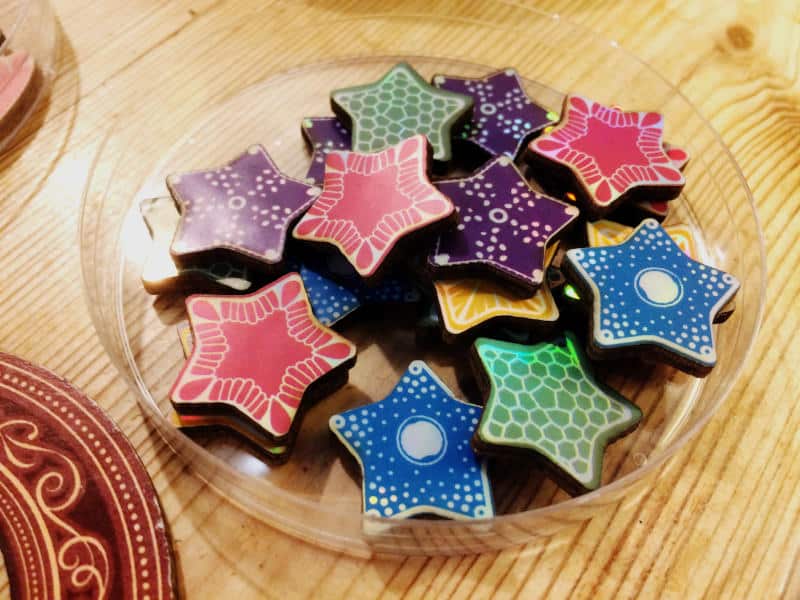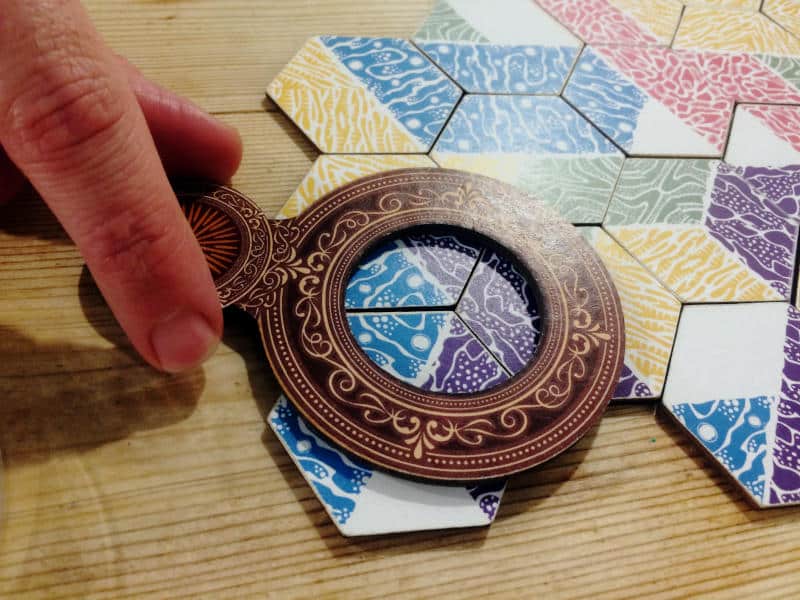| Release Date: 2024 | Players: 1-4 |
| Designer: Sabrina Culyba | Length: 30-45 minutes |
| Artist: Nim Ben-Reuven | Age: 8+ |
| Publisher: Ludoliminal | Complexity: 1.5 / 5 |
| Plastic (by weight): n/a | Air (by volume): n/a |
There. It was done. The mosaic was complete. It was tiny, about the size of a full stop. However, under the microscope, it glistened and glinted, it sparkled and shined. It was a wonderfully symmetric arrangement, forming the overall shape of a circle, intersected into various quadrants. Yet, it was more than just geometry and scientific fascination. It was art. There they were, the wonderful Diatoms by Sabrina Culyba from Ludoliminal.
These tiny pieces of artistry that were so popular in the latter part of the 1800s, have now become the setting for a new tile-laying, pattern-matching and algae-arranging family game. As the winner of the 2023 Cardboard Edison Award, Diatoms has received high praise. The game has now gone from being unpublished, which is a requirement for the award, to finishing a very successful Kickstarter campaign. So it won’t be long until the game is in people’s hands.
I was privileged to have been given a prototype copy of Diatoms to play and review. So I can’t comment on the components, but if the prototype is anything to go by, the final product will be amazing. The love and attention are very clear. There are plastic Petri dishes, which hold sparkly and shiny diatoms. The player boards are dual-layered, with cut-outs for one of two specific types of diatoms. Setting up Diatoms alone is a real pleasure and at the end of the game, you have a beautiful mosaic that you will be proud of and that you want to take a photo of to share.

Calico meets Applejack
Maybe it’s a bit unfair to describe Diatoms as “Calico meets Applejack“, but I did get those sorts of vibes. Of course, Diatoms is a very different game.
As you’re placing your hexagonal water tiles, you not only need to ensure that the colours on the edges match, but that they give you the diatoms you need to score the most points. Ideally, you want to place your hex so that it gives you multiple matches, which will give you even more diatoms, which will hopefully give you even more points. That’s what reminded me of Applejack.
Placing the diatoms you gained into your personal mosaic is the next challenge. You’re aiming for point symmetries, matching colours and as many different types of diatoms as possible all at the same time. It’s going to be very hard to achieve everything, but if you achieve it, you’ll score big. That’s the part that reminded me of Calico, where you have many, almost contradictory, goals.
Yet, Diatoms is a much more gentle game. It is almost a multi-player solitaire game. The only real interaction is in the placement and drawing of water tiles. If you can work out what others need, you are theoretically able to block the space they have their eyes on or draw the tile that they need. In reality, it’s not that easy and there are usually plenty of options for other players to get the diatoms they want. So while you can hate-draft a little in Calico, in Diatoms that is not quite so easy.

Beautiful Diatoms
As it is, the game is really quite gentle and while it will seem a bit confusing the first time you play it, you’ll get better at it quite quickly. In fact, with the basic scoring goals alone, you will probably get bored after probably only a handful of games. Luckily though, the game comes with so-called guest judges, which will throw spanners in the works by trying to get you to score in new and different ways. Those will keep you busy for quite some time, for sure.
However, even without the extra objectives, Diatoms is always fun to play. It’s always fun to work out how to get the diatoms of the right type and colour. Taking the gorgeous diatoms from their Petri dishes is a pleasure. Placing them into available slots in your mosaic is very satisfying. Looking at the final result is a joy. So it’s quite tempting to play just to build the prettiest mosaic and completely ignore the scoring goals.
I certainly think Diatoms is the perfect game for people who love pattern-matching, puzzly styles of games. Despite there having been so many titles in the last 12 months, this game has managed to find a gap and offers a different experience. Of course, it will depend on what you’re after. If you prefer the excruciating pain of trying to find the right tile to complete your Calico quilt and hate-drafting the patch that you know someone else desperately needs, then Diatoms isn’t for you. However, if you want something gentler, that is still challenging, then definitely check out this wonderful game by Sabrina Culyba.
Useful Links
- Diatoms: https://ludoliminal.
com/ diatoms/ - Ludoliminal: https://ludoliminal.
com/ - BGG listing: https://boardgamegeek.
com/ boardgame/ 370210/ diatoms - 2023 Cardboard Edison Award: https://cardboardedison.
com/ 2023-award-results - Diatoms Kickstarter campaign: https://www.
kickstarter. com/ projects/ ludoliminal/ diatoms - Applejack review: https://tabletopgamesblog.
com/ 2023/ 09/ 30/ applejack-saturday-review/
Videos
Transparency Facts
I feel that this review reflects my own, independent and honest opinion, but the facts below allow you to decide whether you think that I was influenced in any way.- I was sent a free review copy of this game by the publisher.
- At the time of writing, neither the designers, nor the publisher, nor anyone linked to the game supported me financially or by payment in kind.
Audio Version
Intro Music: Bomber (Sting) by Riot (https://www.
Music: End Titles Extended Version (Romeos Erbe) by Sascha Ende
Website: https://filmmusic.io/song/3158-end-titles-extended-version-romeos-erbe
Licensed under CC BY 4.0: https://filmmusic.io/standard-license
Playlist
These are the songs I listened to while I was writing this review:

